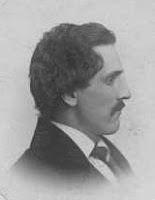Time for another excerpt from The Gossips of Rivertown.
In this episode, the younger generation of talebearers--Miss Harriet Harden and Miss Adeline Mitchell--pay a visit to the subject of their gossip: Miss Mary Butler.
Mary Butler was resolutely practising one of Herz's most brilliant variations when the threatened visit was paid. She did not feel quite at ease as the ladies entered, for she had never liked them, and there was an air of remarkable warmth in their salutations that disconcerted her. However, she tried to conceal her vexation, and kindly entered into the brisk conversation which they at once commenced.
The magazines with which the centre-table was strewn, served to commence a discussion on the relative merits of their fashionplates, and Mary was not a little amused at their decision in favor of that which displayed the most ungraceful figures. From fashions to Miss Martin was an easy transition—"Did Miss Butler ever employ her?"
Mary smiled a little as she replied that, from motives both of taste and economy, she had always chosen to make her own dresses.
The young ladies exchanged glances at this open confession, and Miss Mitchell asked if she had never met Miss Martin at Mrs. Jorden's. Yes, Miss Butler remembered having seen her there two or three days before; she recollected it perfectly, for Mr. Jorden was to have come in that evening, and practised a new duet, but something had prevented.
A second fire of glances was here exchanged, and the young ladies looked back at Mary to see if she was not confused. But strange to say, there was no sign of embarrassment upon her face. Yet she did not seem at ease after all, for she started every time the garden gate opened; they noticed that particularly; and once she went to the window, but it was only the boy from a neighbouring grocery store, with his basket of brown paper parcels.
Conversation languished. Adeline waited for her friend to give the signal for the termination of their call. But no--that young lady was determined to know more of the matter which had occupied her thoughts for the past twenty-four hours. So she recommenced the discussion before alluded to, calling Adeline's attention to a new style of mantilla which had before escaped their observation. Just at this juncture a loud knock--few Rivertown houses can boast of bells--startled them all, and much to the astonishment of her visitors, Mary ran to the street door herself.
They had scarcely time to make a whispered comment, when she re-entered the room with a small parcel in her hand, looking very much flushed and excited, and bade the messenger wait until she saw whether an answer was required. A triumphant glance from Harriet directed Miss Mitchell's attention to the person of Mrs. Jorden's man-servant, who stood leaning against the hall-door, and back again to the deep blush, yes, an unmistakeable blush, that rose to Mary Butler's forehead as she perused the note that accompanied the parcel. Then she tore off the envelope, displaying--could they believe the evidence of their own senses!--a miniature case!
At first she seemed quite to have forgotten their presence, but as she gave one hurried glance at its contents she recalled herself, and begging them to excuse her absence a moment, left the room to write a note of reply. The miniature she evidently forgot in her haste, and it was left lying upon the table in dangerous proximity to Miss Harriet, with the note carelessly beside it.
Miss Harden directed a half-guilty, half-curious look towards her friend; a similar glance responded. But no--they could not so fairly sin against good-breeding, even with such a stimulus; and Adeline Mitchell began turning over the music upon the piano. A new waltz was lying upon the rack, and she ran her fingers over the keys to try it. She really possessed some little musical skill, and becoming interested in the beautiful melody, did not look up until the re-entrance of Mary Butler. As she turned, she noticed that Harriet seemed deeply absorbed in a book she had opened, and that she started with a heightened colour as Mary Butler made an apology for keeping them waiting so long.
Moreover, she did not quite understand why she rose in such haste directly after, and declared she had forgotten an engagement to shop with her mother that morning. As they closed the garden gate, on leaving the house, Harriet called her attention to the parlour window, and she distinctly saw Mary Butler press the miniature to her lips as she took it from its resting-place.
Sketch the Second. More of Mary Butler. Chapter IIIWhose miniature it is? All--well, almost all--will be revealed in the next excerpt from The Gossips of Rivertown.








































